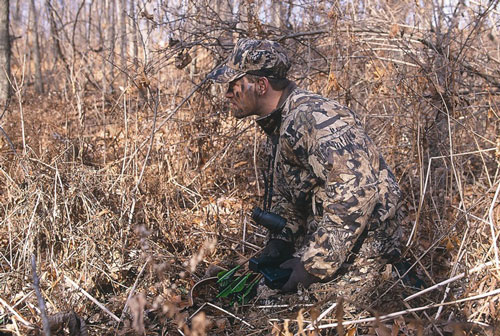Previously: Pre-Rut & Peak Rut Calling
Late-Season Madness
 Calling bucks in the late season can be a trying experience. After all, there are not as many bucks to snort, grunt, bleat, wheeze, click or rattle to as there were prior to opening day, and those that are left are super-spooky after having survived a rigorous firearms season. The weather can also work against you.
Calling bucks in the late season can be a trying experience. After all, there are not as many bucks to snort, grunt, bleat, wheeze, click or rattle to as there were prior to opening day, and those that are left are super-spooky after having survived a rigorous firearms season. The weather can also work against you.
Deer are now concentrated near food sources where they can sometimes be caught flat-footed feeding during the middle of the day when it is the warmest. In farm country, uncut corn lots are a favorite as are apple orchards, alfalfa lots, and hayfields while in the big woods, swamps, acorn/beech ridges and clear-cuts—especially those found on the warmer, south-facing slopes—can attract herds of wintering whitetails.
Your first step is to locate a shooter buck. And one of the best ways to do this is to first spend your evenings glassing known feeding areas from a safe distance, and not hunting.
Survivor bucks will arrive on the feeding grounds last in the evening, and often after legal shooting hours, making them very difficult to pinpoint. You can bet that once you spot such a buck he will be bedded in those thickest tangles closest to the food supply.
So how do you get him to show himself? Slowly prowl the edges of those tangles, stopping often to call. Start with a confidence call, such as a doe bleat, fawn bleat or even a moderately toned buck grunt. This signifies to the bedded buck that the coast is clear and that it is safe to enter the nearby field to feed. Don’t be disappointed if the buck is not at first responsive. He may be hanging out along the edge of the thick stuff waiting for the light to fail. If this happens to you, then you are going to have to sneak in closer to this safety zone the next evening.
Of course, in most cases as long as he has his rack, he is willing and able to breed. Thus an estrous doe bleat is always an acceptable choice. You can double this call with a few moderately toned tending buck grunts. Maybe the old boy will think another buck is about to breed that hot doe, and exit the thick stuff for a quick look-see.
Finally, you can try rattling. Not the crash-bang routine, but a soft tickling of the antlers, much like that what worked in the early season. Bucks are no longer willing to beat each other up for a chunk of territory after the rut winds down. Heck, they are even friends again in the late season and will often feed side by side in the same meadow without incident.
One final note. Do not overcall during the late season. Any more than one or two notes tend to raise a buck’s defenses. In fact, if your grunt tube freezes up, you are definitely overcalling!
Next: Hard & Fast Rules






